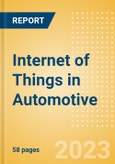The automotive industry was one of the first to adopt IoT technologies. As vehicles become increasingly connected, IoT will stop being differentiated as a premium technology offering and become integrated into all new manufactured vehicles. That maturity will also ensure a broad and steady demand for IoT products and services.
Reasons to Buy
- Understand the impact of the internet of things (IoT) in the automotive sector.
- Access the latest data on the internet of things (IoT) in the automotive sector.
- Identify the leading technological advancements increasing investment into the internet of things (IoT) theme.
- Understand what leading players in the automotive sector are doing in the internet of things (IoT) theme.
Table of Contents
1. Executive Summary2. Technology Briefing
3. Players
4. Automotive Chellenges
5. The Impact of IoT on Automotive
6. Case Studies
7. Market Size and Growth Forecasts
8. Signals
8.1. Mergers and acquisitions
8.2. Patent trends
8.3. Company filing trends
8.4. Hiring trends
9. IoT Value Chain
9.1. Physical layer
9.2. Connectivity layer
9.3. Data layer
9.4. App layer
9.5. Services layer
10. Companies
11. Sector Scorecards
11.1. Vehicle manufacturing sector scorecard
11.2. Parts & tires sector scorecard
12. Glossary
13. Further Reading
14. Thematic Research Methodology
15. About the Publisher
16. Contact the Publisher
Companies Mentioned (Partial List)
A selection of companies mentioned in this report includes, but is not limited to:
- ABB
- Accenture
- Advantech
- Aeris Communications
- Airbiquity
- Alibaba
- Alphabet (Google)
- Alteryx
- AltSource
- Amazon
- Apple
- Arista Networks
- Arm
- Arup
- AT&T
- Atos
- Baldu
- Banma Network Technologies
- Bentley Systems
- Biz4Group
- BMW
- Bosch
- BYD
- Chamberlain Group
- Cisco
- Cognizant
- Continental
- Contus Tech
- Databricks
- Dell Technologies
- Deutsche Telekom
- Ecarx
- Ericsson
- Exeros Technologies
- Ford
- Fortinet
- Fujifilm
- GM
- Hikvision
- Huawei
- IBM
- Infineon
- INRIX
- Juniper Networks
- Lenovo
- McKinsey
- Mercedes-Benz
- Microsoft
- Mobileye
- Mott McDonald
- NetApp
- Nio
- Nissan
- Nokia
- Nvidia
- NXP
- Oracle
- Orange
- Palo Alto Networks
- PTC
- Qualcomm
- Renesas Electronics
- Rockwell Automation
- Salesforce
- Samsung Automotive
- Samsung Electronics
- SAP
- SAS
- Schneider Electric
- Shimadzu
- Sierra Wireless
- Snowflake
- Sony
- STMicroelectronics
- Tata Consultancy Services
- Telefonica
- Tesla
- TKD
- Toyota
- Veoneer
- Visteon
- Vodafone
- Wireless Car
- XPeng








